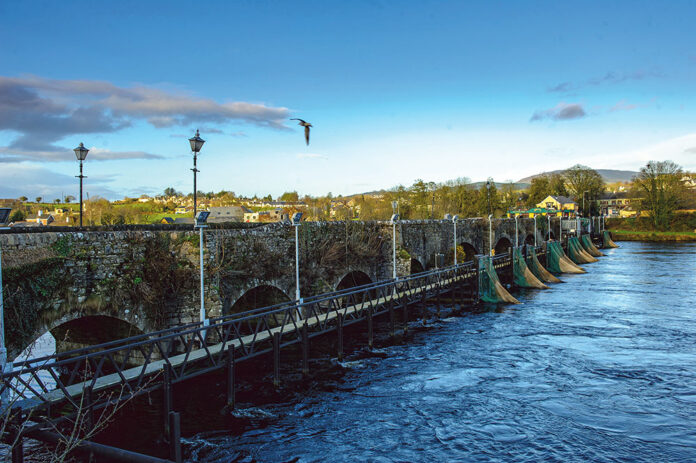VEHICULAR traffic using the historic bridge linking Killaloe and Ballina will drop by an estimated 40% once the new Shannon River Crossing and Killaloe bypass are fully operational.
That according to the analysis supporting the construction of the new Killaloe bypass, which is contained in the draft Killaloe and Ballina Town Enhancement and Mobility Plan (TEMP).
The TEMP aims to promote sustainable travel, provide infrastructure for pedestrian and cyclists, as well as reducing the dominance of cars within both towns and provide further opportunities to reduce vehicular usage of Killaloe Bridge.
Until the bypass and new bridge are open, no changes are proposed to the existing bridge.
However, once the bypass and new bridge are operational, it is proposed to implement the new arrangement for the old bridge.
Apart from bus and emergency vehicles, the old bridge will be closed to traffic every weekday between 10am and 5pm, and on Saturdays and Sundays between 10am and 6pm.
Removing a large amount of the traffic using the bridge allows for the bridge surfacing to be updated to make it a more shared space area, and support the proposals at either end of the bridge, which focus on pedestrians and cyclists, according to the TEMP.
Changing the priority to pedestrians on the bridge will assist in connecting the bridges for locals and tourists in the summer season.
The proposed car parking at each ‘gateway’ into the towns will ensure that visitors will have a location to park their car without driving into the towns and reduce the need to cross the bridge via car.
This will reduce a significant proportion of congestion within the towns and further make it a more attractive and enjoyable place to be.
The new Killaloe bypass will benefit from integrated, good quality pedestrian and cyclist infrastructure.
This will consist of a 2.5 metre footpath on one side of the carriageway and a 2.5 metre cycleway on the other side. In the bridge section of the bypass this adjusts to a three-metre shared route on both sides of the carriageway.
A key element of the TEMP is ensuring the bypass does not cause severance within Killaloe for pedestrians and cyclists, in particular around Clarisford Park.
The proposals within the TEMP have been designed to tie into and connect with the by-pass. This includes proposing to upgrade the existing link adjacent to St Anne’s Community College for pedestrians and cyclists once the bypass is operational.
This will then tie into the proposed uncontrolled pedestrian crossing on the bypass within the desired line to connect to the new road. Clare County Council has proposals to upgrade the pedestrian route to the south of the bypass.
The combined improvements will all connect up to provide direct pedestrian and cyclists links to/from Clarisford Park and Killaloe.
Improvements to the pedestrian and cyclist infrastructure are proposed on the R494 Main Street in Ballina to tie into the proposed wider improvements from the by-pass/R494.
Vehicles requiring access to/from Clarisford Park will instead use the R463 to connect to the by-pass at Shantraud roundabout and then exit via the new southern link.
The existing link road adjacent to St Anne’s Community College, which currently links to Clarisford Park, will no longer provide vehicular access.
It is proposed to try to reduce the dominance of cars within Killaloe with a combination of several measures. This includes pedestrian priority of Bridge Street and closing vehicular access at Killaloe bridge junction.
It proposes hard surface/pedestrian priority of John Street and Carrick’s Lane, with vehicular access for local residents/businesses only.
The footpath is to be widened and a significant amount of car parking on Main Street will be removed. A widened footpath and new cycle lanes on Abbey Street are also envisaged.
These proposals tie into proposed pedestrian/cyclist infrastructure for the new bypass and Shannon River crossing.
The plan wants to upgrade existing bus shelters and increase provision of bus stops; upgrade existing pedestrian crossing on New Street and provide new crossing on Convent Hill; and improve cycle parking provision.
The proposed changes do not require any changes to the one-way system or existing traffic routes. There are still several alternatives connecting Main Street and Abbey Street.
Closing Bridge Street to traffic will benefit the Killaloe bridge junction by improving available green time for the Royal Parade and Canal Bank traffic signals.
Changing John Street to shared surface with pedestrian priority should help address any congestion issues around St Mercy Convent school during pick-up/drop-off periods and further encourage local residents to walk/cycle to school instead of driving.
This will require coordination with the local schools and supporting measures such as a School Travel Plan to ensure success.
Removable or raised bollards could be provided to ensure only local vehicles use these lanes.
A potential nearby site has been identified to provide car parking for resident parking spaces displaced on Main Street. This is subject to local ownership details.
Within Killaloe, it is proposed to rationalise the car parking on Main Street/The Green and on Abbey Street. It is proposed to provide a designated car parking location on The Green for local residents to use.
The proposed resident parking location is just a 100m walk from Main Street, so it is still convenient for locals to use.
The proposed parking location can accommodate circa 42 spaces which is considered appropriate to meet local demand.
In addition, to help mitigate the rationalisation of car parking on Abbey Street/Convent Hill as well as the pedestrianisation of John Street, it is proposed to formalise an arrangement for residents/local businesses to utilise the community parking spaces located at the front of the Aldi car park on Abbey Street/Convent Hill.
Submissions or observations must be made in writing to Clare or Tipperary County Council before Friday, August 5.
by Dan Danaher

